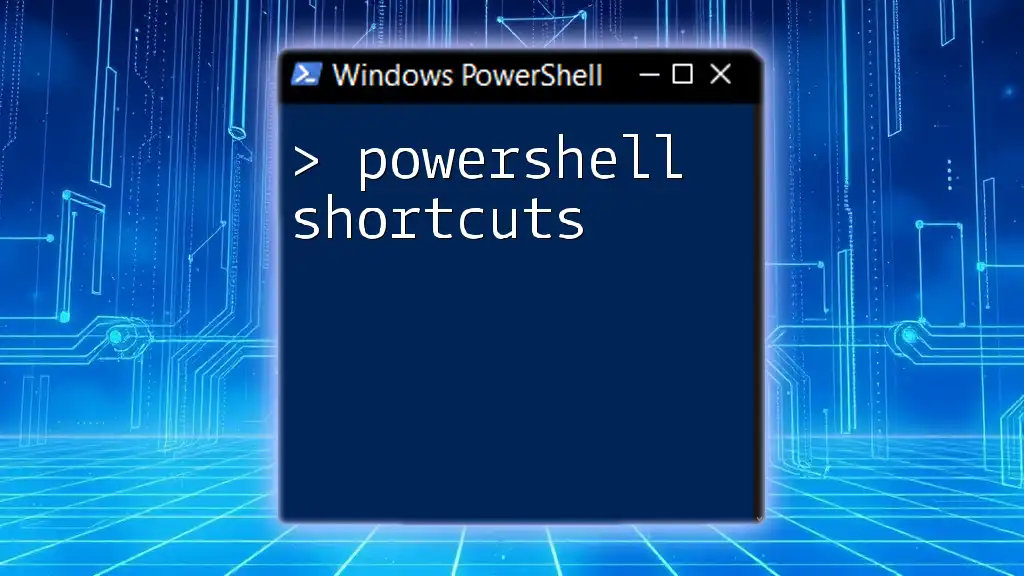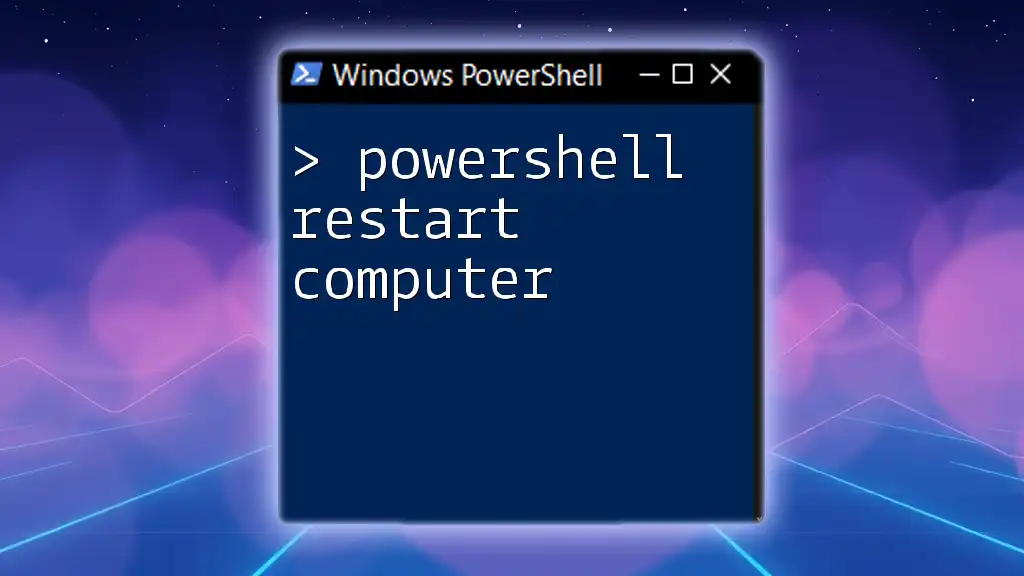PowerShell shortcuts streamline your command-line experience by allowing you to execute common tasks efficiently with concise commands.
Here's a simple example of a PowerShell shortcut that retrieves the current directory:
Get-Location
Understanding the PowerShell Command Line Interface
PowerShell has grown to encompass a robust command line interface promoting automation and simplified management of tasks in Windows environments. To get started, it’s crucial to understand the environments available, notably the PowerShell console, Integrated Scripting Environment (ISE), and third-party editors like Visual Studio Code.
PowerShell Console vs ISE and VSCode
While the PowerShell console focuses on command execution, ISE provides a more visual approach with features like syntax highlighting and integrated debugging tools. Visual Studio Code, on the other hand, extends beyond PowerShell with significant plugins that enhance coding experience with IntelliSense and Git integration.
Basic Navigational Shortcuts
Mastering basic navigational shortcuts significantly improves efficiency when interacting with PowerShell.
Using Tab for Autocomplete
One of the most valuable shortcuts is the use of the Tab key, which allows users to autocomplete commands. For instance, typing `Get-` and hitting Tab will toggle through available cmdlets that start with those letters, saving crucial time and reducing typographical errors.
Using the Up and Down Arrow Keys
Navigating through your command history with the Up and Down arrow keys will enable you to quickly access previous commands. This feature becomes particularly useful during extensive scripting sessions where retyping commands can become redundant.
Clear-Host Command
At times, your console may become cluttered with output. The `Clear-Host` command can be employed to quickly clean the console for improved readability. Simply type:
Clear-Host
Executing this command provides a fresh workspace, which is especially helpful when working with numerous commands and outputs.
Essential Keyboard Shortcuts in PowerShell
Keyboard shortcuts streamline command editing and console navigation.
Editing and Navigation Shortcuts
Utilizing the Home and End buttons enables quick movement to the start or end of a command line, creating a smoother workflow when editing or correcting commands.
Ctrl + A: Select All
The shortcut Ctrl + A allows users to select all text in the console. This is particularly useful for copying code snippets or outputs that you want to manipulate further.
Ctrl + C/Ctrl + V: Copy/Paste
In most contexts, copying and pasting text before executing commands is straightforward. However, PowerShell emphasizes using Ctrl + Shift + C to copy and Ctrl + Shift + V to paste. This differentiation prevents conflicting with the default behavior of these shortcuts in other applications.
Ctrl + Up/Down Arrow
Scrolling through previous output with Ctrl + Up/Down Arrow will enable quicker analysis of results without the need to rerun commands.
Frequently Used PowerShell Cmdlets
Alias Overview
In PowerShell, an alias is a shorthand reference to a cmdlet or function, effectively reducing the typing burden on users. Through the use of aliases, users can navigate and execute commands more fluidly.
Commonly Known Aliases
PowerShell comes with many predefined aliases, enhancing command expediency. For example:
-
`ls` for `Get-ChildItem`
Typing `ls C:\` will display the contents of the C drive, much like using the traditional `dir` command in CMD. -
`cp` for `Copy-Item`
To copy a file quickly, using `cp file.txt C:\Backup\` allows for a straightforward transfer without the verbose syntax.
Creating Your Own Aliases
Crafting personalized aliases can further optimize your workflow. You can use the following code to create a simple alias:
Set-Alias -Name gs -Value Get-Service
This allows you to type `gs` instead of the full command, making repeated calls to check service status much quicker. You can ensure these aliases persist across sessions by adding them to a PowerShell profile.
Shortcuts for Command Execution
Piping and Redirection Shortcuts
PowerShell leverages powerful piping functionality allowing the output of one command to be passed as input to another. The pipe (`|`) is instrumental in building efficient one-liners. For example, you can filter for CPU-intensive processes as follows:
Get-Process | Where-Object { $_.CPU -gt 100 }
Output redirection is another fundamental command. By using the `>` operator, you can dump the results of a command into a file:
Get-Process > Processes.txt
Utilizing `>>` allows appending results to an existing file, preserving previous information.
Best Practices for Efficient Scripting
Script Optimization Techniques
Creating functions for repetitive tasks can elevate your scripting capabilities. For instance, the following simple function helps to retrieve the latest file in a directory:
function Get-LatestFile {
param([string]$path)
Get-ChildItem $path | Sort-Object LastWriteTime -Descending | Select-Object -First 1
}
This function optimizes repeated actions and makes scripts cleaner and more maintainable.
Using Parameters for Flexibility
Incorporating parameters allows you to customize the function further. For example, you can extend `Get-LatestFile` to accept file types or limits on the number of files returned, making it a robust utility.
Utilizing Integrated Scripts with Shortcuts
Combining the use of shortcuts and functions can lead to highly efficient scripting practices, minimizing redundancy and enhancing maintainability.
Common Mistakes and How to Avoid Them
Mistakes Beginners Make
Often, beginners neglect the importance of thorough documentation, leading to confusion in complex scripts. Additionally, a reliance on memorization of commands can hinder learning.
Best Practices to Mitigate Errors
To avoid these pitfalls, it’s highly recommended to frequently refer to official PowerShell documentation and surrounding community support. Testing and breaking down scripts can expose errors early, leading to more successful automation efforts.
Conclusion
Enhancing your workflow with PowerShell shortcuts can transform your command line interactions into a streamlined, efficient experience. Your ability to leverage autocomplete features, keyboard shortcuts, and commands will improve your productivity significantly. Regular practice and exploration of advanced commands and scripting techniques will yield greater results and deeper comprehension of the PowerShell environment.
Additional Resources
For those looking to deepen their knowledge, several resources can be invaluable. Explore the official PowerShell documentation for comprehensive cmdlet listings and advanced functionalities. Engaging with the PowerShell community and forums can provide additional insights, troubleshooting advice, and support during your learning journey. Consider online courses to gain structured knowledge and hands-on practice for mastery of PowerShell.










